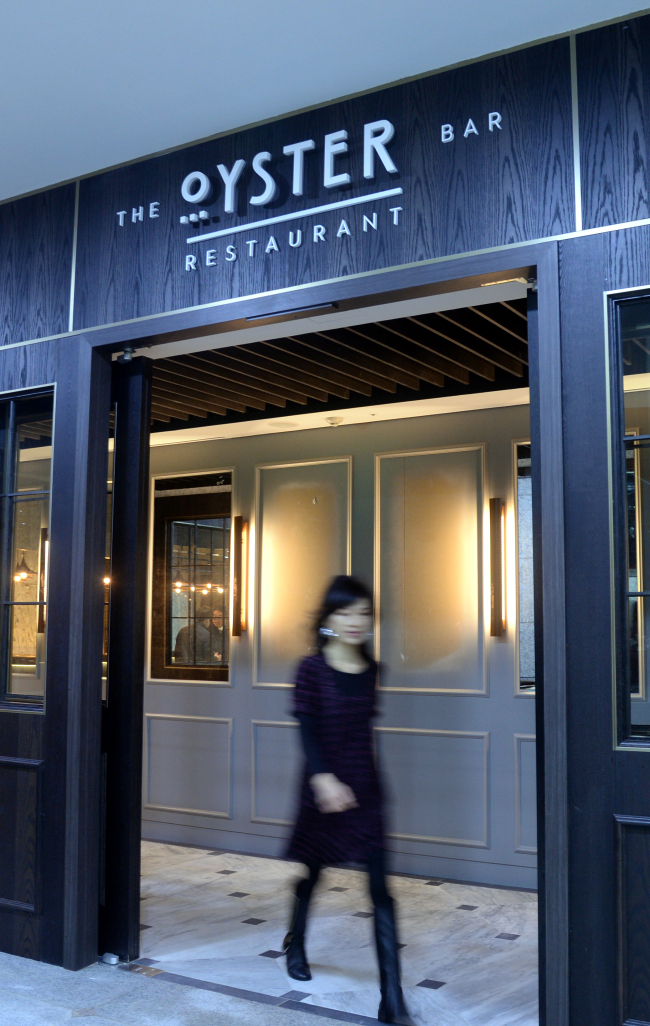뉴스속보 상세보기
 |
| The Oyster Bar will serve Osole oysters from Korea’s Seocheon County as well as other Korean oysters from Tongyeong City and Goheung County. (Park Hyun-koo/The Korea Herald) |
Here in Korea to train the guys at The Oyster Bar, a restaurant opening Monday in Seoul’s Yeouido, the 56-year-old consultant definitely knows his way around a shell.
“I like opening my oysters from the hinge,” the Hong Kong-based pro said while swiveling the knife into the pointed end of the oyster and opening the shell.
Stewart then slid the blade underneath and deftly flipped the oyster over so that its plump underbelly lay face up, submerged in its own briny juice.
It looked deceptively simple. Then again, Stewart has had decades of experience shucking oysters.
“I have been known to have opened around 8 million oysters in Hong Kong since I started this business,” he said.
 |
| Oyster consultant John Stewart demonstrates how to open an Osole oyster from the hinge at The Oyster Bar. (Park Hyun-koo/The Korea Herald) |
Now he is here in Korea to pass on his know-how, working his expertise on regional morsels like the Osole oyster, which The Oyster Bar owner Han Jinse referred to as the “Louis Vuitton of oysters.”
“They taste very, very top standard,” Stewart said of Osole oysters, which hail from Seocheon County, South Chungcheong Province, and according to The Oyster Bar’s website are “five times larger than the basic oyster and rich in amino acids.”
Large indeed, as tipping back an Osole, in fact, can be quite a challenge. Once down the hatch, the flesh mingles with the saltiness of its juice before divulging its mind-blowing sweetness.
Not sugary in a cloying way, the Osole possesses a very subtle sweetness, one that slowly spreads like honey on the tongue.
Stewart praised the regional delicacy, saying it tastes “very close to French oysters,” which have been “well known for centuries as top-end oysters.”
In short, the Osole seems to meet one of the three requirements that Stewart sets forth for the ideal oyster experience.
What are those three requirements?
According to Stewart, one needs a good oyster, a good shucker, and a good wine.
Some might wonder what Stewart means by a good oyster, while veteran foodies will rattle off a list ― either by variety or specific names given to them by their oyster farmers ― that reads like a ranking of A-list celebrities.
For example, there are the famed French Belon or Gillardeau oysters, which Stewart says bear melon and cucumber aftertastes, and other prominent oysters like the Kumamoto or the Olympia.
Once one has the oyster, then one needs a talented shucker, someone who can open and present those delicacies with ease and skill, and that is not an easy skill to master, just take it from the two guys who are learning from Stewart.
“Shucking is different for each variety,” said The Oyster Bar shucker Kim Hyun-su, who has been opening around 30 to 40 oysters daily so that when the restaurant opens he will have it down pat, a must when serving customers directly at the bar.
Shuckers Kim Hyun-su and Kim Ji-hun not only have to learn how to open Osole oysters from Seocheon County, but both guys also have to work with Tongyeong City and Goheung County oysters from Korea, Kumamoto oysters from the U.S. and the famed Gillardeau as well as Regal and Majestic oysters from France.
That is a long list of oysters to shuck for patrons of the soon-to-open restaurant, especially when it is not an easy job to master.
“Be very, very careful when opening oysters,” said Stewart, who revealed he is also teaching both guys how to sort out the bad ones from the good ones.
“Sometimes they are empty,” Stewart elaborated on which ones are duds, explaining there are also times when an oyster is slightly open. If that kind of oyster does not close when tapped on the shell, it must be discarded.
Then there are the obviously bad oysters, which he says give off “the most disgusting smell you can ever have.”
Once the bad ones have been discarded, then there is the question of how to enjoy the good ones.
“Just lemon juice,” said Stewart. A purist at heart, he recommends eating them raw, with some black pepper and a squeeze of lemon, so one can enjoy the varied flavors and textures of each oyster, which, says Stewart, can be sweet, crunchy or crispy.
For those who are not fond of raw oysters, Stewart says classic cooked versions like oysters Rockefeller and Kilpatrick are standard introductory dishes for newbies, both of which will be on The Oyster Bar’s menu.
According to The Oyster Bar executive chef Laurent Beltoise, both dishes will be on a menu that promises to show diners “different ways of eating oysters.”
As for the real oyster fiends who want to slurp them down raw, Beltoise recommends taking a seat at the oyster bar.
“Sit there if you only want oysters.”
The Oyster Bar
 |
| The Oyster Bar opens Dec. 9 in Yeouido-dong, Seoul. (Park Hyun-koo/The Korea Herald) |
www.theoysterbar.kr
Open from 11:30 a.m. to 3 p.m., 6 p.m. to 10 p.m., bar open from 5 p.m. to midnight, daily
Osole oysters cost 5,000 won per piece, Goheung oysters cost 1,500 won per piece, Tongyeong oysters 1,000 won per piece, oysters Rockefeller and Kilpatrick cost 7,500 won for three
By Jean Oh (oh_jean@heraldcorp.com)


